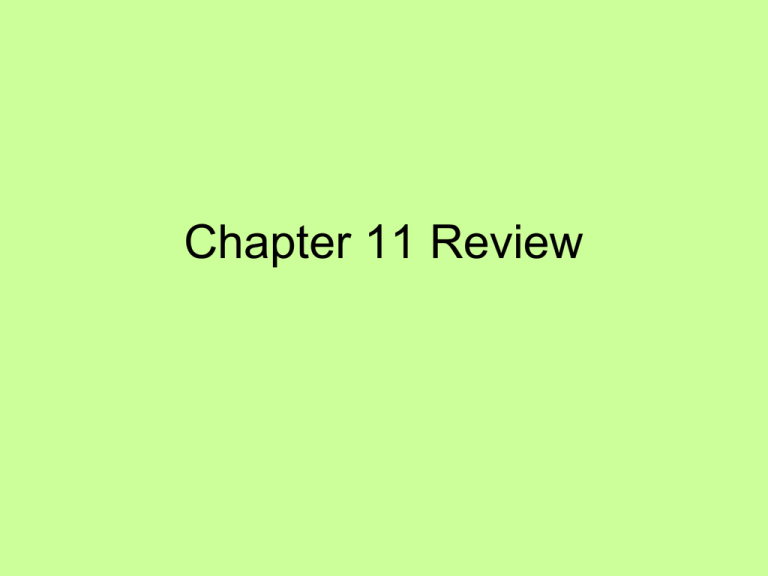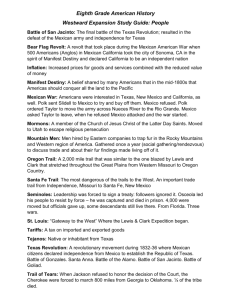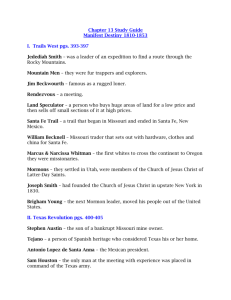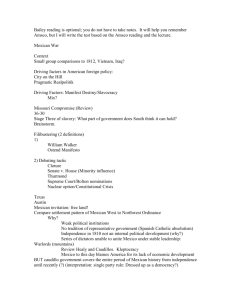Chapter 11 Review - Yourclasspage.com
advertisement

Chapter 11 Review 1. What caused the American fur trade to move westward in the early 1800s? a. Fur companies wiped out the beaver population in the East in their effort to meet European demand for the popular “high hat.” b. Fur trappers called “mountain men” wanted to be the first to map western territory and asked the American Fur Company to sponsor their journey. c. The American Fur Company sent mountain men to the West in its effort to beat its competitors from Europe and the East. d. American Indian trappers from the Pacific Northwest were acclaimed for their skill and eastern companies wanted to know their secrets. a. Fur companies wiped out the beaver population in the East in their effort to meet European demand for the popular “high hat.” 2. All of these were challenges that pioneers faced on the Oregon Trail EXCEPT? a. shortages of food, supplies, and water b. mistreatment by American Indians c. barriers such as mountains d. the high cost of moving a family b. mistreatment by American Indians 3. Which was true about the Oregon Trail? a. It ran through the Appalachian Mountains. b. It was a gravel paved road that made travel much easier than normal trails c. It required protection by U.S. government troops. d. It took six months to travel. d. It took six months to travel. 4. When they first moved from New York in the early 1830s, what did Mormons hope to find in the West? a. gold and other natural resources b. a sense of religious freedom c. a site for their Great Temple d. a set of silver tablets with religious teachings b. a sense of religious freedom 5. Which practice caused Mormons to be persecuted in the 1850s? a. the ritual slaughter of animals b. the circumcision of newborn males c. marriage to more than one wife d. sacrificing humans to the sun god c. marriage to more than one wife 6. By December 1860, the Mormon population of Utah had reached about 40,000 people because of the efforts of which church leader? a. Brigham Young b. Joseph Ratzinger c. Joseph Smith d. L. Ron Hubbard a. Brigham Young 7. Why did Mexican priest Father Miguel Hidalgo y Costilla lead about 80,000 American Indians and mestizos in a rebellion in 1810? a. The people were uprooted and thought an attack would push American settlers back over Mexico’s northern border. b. The priest believed that the “meek will inherit the earth” and wanted to make the Christian dream a reality. c. The people were poor and thought independence from the Spanish monarchy would improve their lives. d. The priest believed that Mexico should have a Christian king and wanted to take the place of the secular monarch. c. The people were poor and thought independence from the Spanish #8 Who was Stephen F. Austin? a. an empresario who started a colony on the lower Colorado River in 1822 b. an American agent who enforced Mexico’s laws on new settlers until 1830 c. the only American to witness the signing of the Mexican constitution in 1824 d. a southern settler who spurred Texans to defy the ban on slavery in 1831 a. an empresario who started a colony on the lower Colorado River in 1822 #9 After 1824, all of the following created conflicts between the Mexican government and American settlers in Texas EXCEPT Mexico’s a. requirement of citizenship. b. prohibition on importing slaves. c. strict enforcement of its laws. d. heavy taxation of settled lands. d. heavy taxation of settled lands. #10. “…I call on you in the name of Liberty, of patriotism, and everything dear to the American character, to come to our aid with all dispatch [speed]…VICTORY OR DEATH.”--from a letter written by William Travis Travis wrote those words during the build-up to which important battle of the Texas War for Independence? a. the Battle of Goliad b. the Battle of the Alamo c. the Battle of Gonzales d. the Battle of San Jacinto b. the Battle of the Alamo 11. Why was the Battle of the Alamo significant to the outcome of the Texas Revolution? a. Frontiersman Davy Crockett and Colonel Jim Bowie joined the Texan defenses. b. The Texans were beaten, but Sam Houston’s forces were inspired to win the Battle of San Jacinto. c. Prisoners who had surrendered at Goliad were released, adding to the Texan defenses. d. The Texans suffered heavy losses, but the survivors overcame Antonio López de Santa Anna’s army. b. The Texans were beaten, but Sam Houston’s forces were inspired to win the Battle of San Jacinto. 12. President Jackson refused to annex Texas because doing so would have a. upset the balance between free and slave states. b. gone against the wishes of Congress. c. encouraged wars of independence in other border areas. d. admitted to the British that western expansion had ended. a. upset the balance between free and slave states. 13. What is another way of saying “manifest destiny”? a. “clear choice” b. “people’s future” c. “obvious fate” d. “humanity’s end” c. “obvious fate” 14. How did the slavery issue get tied up with “manifest destiny” in the 1840s and ’50s? a. Slaveholders did not know if ownership claims would be honored in the new territories. b. Americans did not know if the institution of slavery would be allowed in the new territories. c. Slavery went against the democratic values implied by the philosophy of “manifest destiny.” d. Southern slaveholders thought expansion in the spirit of “manifest destiny” would cause their region to lose power. b. Americans did not know if the institution of slavery would be allowed in the new territories. 15. Why did President John Tyler, a Whig from Virginia, favor the annexation of Texas during the Election of 1844? a. He was pressured by southerners who threatened to give their votes to Senator Henry Clay. b. He wanted Texas to be a free state that could not compete with the South’s plantations. c. He thought the annexation of Texas would increase the power of southern slave states. d. He stood in opposition to James K. Polk, who ran on a platform against annexation. c. He thought the annexation of Texas would increase the power of southern slave states. 16. Americans cried “Fifty-four forty or fight!” in reference to a. the line to which they wanted their northern territory to extend. b. the number of prisoners they wanted Santa Anna to release. c. the line that marked the northern border of what is now California. d. the number of American fighters whose deaths they wanted to avenge. a. the line to which they wanted their northern territory to extend. 17. Who referred to a piece of land as a “stolen province,” and what were they talking about? a. The British, about Oregon Country b. The American Indians, about Utah c. The Mexicans, about Texas d. The Spanish, about California c. The Mexicans, about Texas 18. In 1821, Mexico won its independence from Spain. What happened in California as a result? a. Californios fought for independence from Mexico. b. American Indians were given parcels of land called ranchos. c. Mexican businessmen planned a rail route to Canada. d. Mexican officials terminated the mission system. d. Mexican officials terminated the mission system. 19. What happened during the Bear Flag Revolt? a. A union of Spanish settlers rose up against the Californios in the Mission district of San Francisco. b. John C. Frémont’s mapping expedition fought off a black bear while crossing the Sierra Nevadas. c. General Taylor led his troops across the Rio Grande to protect Texas against a Mexican uprising. d. A small group of Americans seized the town of Sonoma and declared California’s independence. d. A small group of Americans seized the town of Sonoma and declared California’s independence. 20. How did the Treaty of Guadalupe Hidalgo, signed in 1848, affect the United States? a. It drew the border line that divides the U.S. from Mexico to this day. b. It enabled the U.S. to collect $18 million in property taxes from Mexico. c. It increased the size of the U.S. by almost 25 percent. d. It gave the U.S. the southern parts of present-day Arizona and New Mexico. c. It increased the size of the U.S. by almost 25 percent. 21. How did the Gadsden Purchase benefit the United States? a. It promised to safeguard the property rights of longtime U.S. residents. b. It allowed the U.S. to purchase the northern part of present day Arizona. c. It gave the U.S. hunting rights in the area of Texas north of the Rio Grande. d. It secured a southern route for a transcontinental railroad on American soil. d. It secured a southern route for a transcontinental railroad on American soil. 22. How did Brigham Young’s influence resolve the western dispute over water rights? a. Young supported the eastern U.S. tradition regarding equal access to water. b. Young felt that irrigation was less effective than dams or canals for large-scale agriculture. c. Young promoted the idea that the good of the community should outweigh the interests of individuals. d. Young felt that addressing individual water use was the key to resolving the problem for the entire community. c. Young promoted the idea that the good of the community should outweigh the interests of individuals. 23. In the 1830s to 1840s, why did a growing number of Americans travel the California Trail? a. Recently published Anglo-Californian guidebooks persuaded settlers to move to the region. b. American and Mexican merchants would meet in California to trade factory-made goods for precious coins, hides, and tallow. c. Taken by the spirit of “manifest destiny,” many Americans decided to settle permanently at the continent’s western edge. d. American cattle ranchers were attracted by the Spanish government’s promise of Mexican land. b. American and Mexican merchants would meet in California to trade factory-made goods for precious coins, hides, and tallow. 24. What lesson might a western traveler have learned from the story of the Donner party? a. “There are no good shortcuts.” b. “Don’t always trust what you read in the papers.” c. “Always travel with a friend.” d. “Help is on the way.” a. “There are no good shortcuts.” 25. Which description fits the group of people known as “forty-niners”? a. gold-seekers from America and abroad who migrated to California b. individualistic prospectors of California gold-mining sites c. middle-aged married men with previous gold-mining experience d. Mexicans and South Americans who immigrated to find gold a. gold-seekers from America and abroad who migrated to California 26. Which of these statements about the consequences of the Gold Rush years is true? a. The population of San Francisco grew, by over twenty-five times, to more than 25,000. b. The vast majority of gold-rush miners left California and took their earnings to their families back east. c. Mexicans and South Americans came to make up the largest foreign group in the mining region. d. The large amount of gold in circulation in California caused severe deflation, meaning prices dropped. a. The population of San Francisco grew, by over twenty-five times, to more than 25,000 27. What happened to California’s population as a result of the Gold Rush? a. The population grew, but not as much as it had during the Spanish and Mexican periods of settlement. b. Immigrants and Americans flocked to California to “get rich quick” and stayed to build a stable frontier society. c. The population boomed during “gold fever,” but declined just as quickly because of inflation. d. Californios and American Indians still outnumbered immigrants and Americans after the Gold Rush. b. Immigrants and Americans flocked to California to “get rich quick” and stayed to build a stable frontier society. 28. As a result of the population explosion of the “gold fever” years, California became a. eligible for statehood. b. more populous than any other region in the country. c. richer than any other region in the country. d. off limits to new immigrants. a. eligible for statehood. 29. What role did the Transcontinental Railroad play in California’s development? a. It contributed to California’s population explosion by bringing settlers to the West in the mid-1850s. b. It gave California’s economy the means to grow by connecting the state to the rest of the country. c. It slowed down California’s economy because it took two decades and many thousands of dollars to complete. d. It damaged California’s environment by requiring the development of coal mining and timber industries. b. It gave California’s economy the means to grow by connecting the state to the rest of the country. 30. Which of the following was least important to the South’s economy in the 1830s? a. small farming b. plantation agriculture c. manufacturing d. trade c. manufacturing 31. Which of the following was not a difference between the North and the South ? a. conflicting views on the issue of slavery b. different economic interests c. disagreement over the Indian removal policy d. disagreement over protective tariffs c. disagreement over the Indian removal policy 32. What was the main job of the early mountain men of the West? a. to make maps b. to trap furs to trade with merchants c. to establish friends with Native Americans d. to cut roads through the mountains b. to trap furs to trade with merchants 33. Which of the following foreign nations did not have claims to the Oregon Territory in the 1800s? a. Spain b. France c. England d. Russia b. France 34. Which of the following trails led settlers west from either Independence, Missouri or Council Bluffs, Iowa to the Willamette Valley a. California Trail b. Mormon Trail c. Oregon Trail d. Santa Fe Trail c. Oregon Trail 35. What trail led merchants and settlers west from Independence, Missouri to New Mexico? a. California Trail b. Mormon Trail c. Oregon Trail d. Santa Fe Trail d. Santa Fe Trail 36. Who founded the Church of Jesus Christ of Later-Day Saints? a. Brigham Young b. Jim Bridger c. Jedediah Smith d. Joseph Smith d. Joseph Smith 37. Who was the leader of Mexico after they won their independence from Spain? a. Miguel Hidalgo y Costilla b. Antonio Lopez de Santa Anna c. Comte de Rochambeau d. Bartolome de Las Casas b. Antonio Lopez de Santa Anna 38. What battle of the Texas Revolution has stood for years as a lasting image of Texas independence? a. San Jacinto b. Mexico City c. Alamo d. Veracruz c. Alamo 39. What was the fight for California’s independence from Mexico called? a. The Battle of San Francisco b. The Bear Flag Revolt c. The San Diego Revolt d. The San Jacinto Slaughter b. The Bear Flag Revolt 40. After Texas won its independence from Mexico who was elected as the President of Texas? a. Stephen F. Austin b. Jim Bowie c. Davy Crockett d. Sam Houston d. Sam Houston 41. What was the main reason that James K. Polk won the presidency against Henry Clay in the election of 1844? a. the economy b. the Spanish-American War c. the expansion issue d. the fight over slavery c. the expansion issue 42. Britain and the United States decided on the northern border of Oregon at what point? a. the 49th Parallel b. the 60th Parallel c. the 54th Parallel d. the 63rd Parallel a. the 49th Parallel 43. What were the early Mexican residents of California who lived so far away from their government called? a. Mestizos b. Mexicanos c. Creoles d. Californios d. Californios 44. What was the name of the treaty that ended the Mexican and American War? a. Treaty of San Jacinto b. Treaty of Guadalupe Hidalgo c. Treaty of San Marcos d. Treaty of Sierra Madre b. Treaty of Guadalupe Hidalgo 45. Who was the German immigrant that designed heavy denim pants for miners? a. James Wrangler b. Guido Sarduci c. Robert E. Lee d. Levi Strauss d. Levi Strauss 46. At what battle were approximately 200 rebel volunteers able to hold off Mexican General Antonio Lopez de Santa Anna with about 1800 troops for 12 days at an old mission outside of San Antonio?? a. Battle of San Jacinto b. Battle of the Alamo c. Battle of Buena Vista d. Battle of Goliad b. Battle of the Alamo 47. At what battle was Colonel James Fannin and 350 Texans taken prisoner and executed under the orders of General Antonio Lopez de Santa Anna? d. The Battle of Goliad 48. Why did President Polk send diplomat John Slidell to Mexico City? a. To explain that we had c. To discuss where Texas decided to declare war on should put their capital them and wanted to give following it gaining its them advanced notice before independence from Spain we attacked and Mexico b. To try and settle the border dispute by purchasing New Mexico and California d. To get Mexico to pay the United States not to attack them to pay off our war debts from the Mexican-American War. •B. To try and settle the border dispute by purchasing New Mexico and California 49. Where was the disputed territory between the United States and Mexico? a. The far Northwestern part c. The area between Mexico of the Mexican Territory in City and the ancient city California between San Tenochtitlan. Francisco and Los Angeles. b. The Southwestern part of d. The Southern parts of Texas between the Nueces Arizona and New Mexico. River and the Rio Grande River. b. The Southwestern part of Texas between the Nueces River and the Rio Grande River. 50. What location did President Polk send Zachary Taylor to take up camp in March of 1846, knowing it would irritate the Mexican Army and most likely provoke a fight? a to the northern . border of the Rio Grande River c to the far western . part of Mexico near Tijuana. b to San Diego which d to Buena Vista . was southeast of . which was North of San Franciso. Mexico City. a. to the northern border of the Rio Grande River 51. What American general defeated the Mexican general, Antonio Lopez de Santa Anna in bitter fighting with many casualties at the Battle of Buena Vista in February of 1847?? a Andrew Jackson c Zachary Taylor . . b Stephen F. Austin d Winfield Scott . . a. Andrew Jackson 52. Who was the American general that defeated General Antonio Lopez de Santa Anna and took Mexico City on September 14, 1847?? a Andrew Jackson c Zachary Taylor . . b Stephen F. . Austin d Winfield Scott . d. Winfield Scott 53. What was the name given to the acquisition of the entire states of Nevada, California, and Utah and parts of Arizona, New Mexico, Colorado and Wyoming called? a. b. c. d. Gadsden Purchase The Louisiana Purchase Mexican Cession Spanish Cession c. Mexican Cession 54. How much did we agree to pay Mexico for the acquisition of the entire states of Nevada, California, and Utah and parts of Arizona, New Mexico, Colorado, and Wyoming?? a. 5 million dollars c. 30 million dollars b 15 million dollars . d 100 million dollars . b. 15 million dollars 55. Which of the following were types of discrimination that Native Americans and Mexican Americans faced in the areas the United States acquired in the treaty that ended the Mexican-American War? a. Legal b. Economic c. Social d. All of the above d. All of the above 56. Which of the following describe the type of searching for gold called “placer mining”? a. digging shallow into the earth and breaking rocks using a hammer and pick c. taking a large hammer or sledgehammer to break boulders into smaller rocks hoping to find gold b. using a pan or other device d. using dynamite or nitro to wash gold nuggets out of glycerin to blow up small loose rock or gravel areas and look for shiny rocks. b. using a pan or other device to wash gold nuggets out of loose rock or gravel 57. Which of the following best describes the average forty-niner? a. young unmarried men c. hard working men with in search of adventure families that had debts that finding gold would fix b. middle aged men whose wife had left them and they had nothing to lose d. foreigners from India, Russia, and the Middle East a. young unmarried men in search of adventure 58. What foreign country that suffered famine and economic hardships had men come to California looking for great wealth and then planned to return home?? a India . c China . b Russia . d Germany . C. China 59. What was the name given to forty-niners that were looking and trying to find gold in California? a Searchers . c Prospectors . b Panners . d Entrepreneurs . c. Prospectors 60. Which of the following were agents that the Mexican government hired to bring settlers into the area of Texas? a. Empresarios b. Californios c. Vaqueros d. Gambusino a. Empresarios • All Done!





